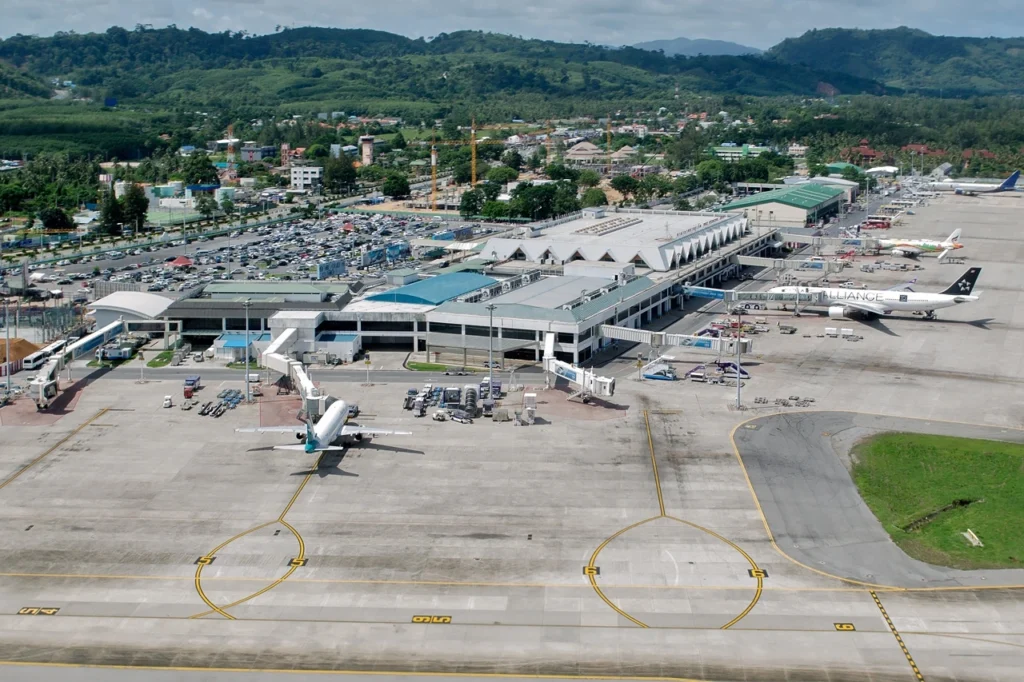
В декабре 2024 года авиационный рынок Юго-Восточной Азии достиг значительного роста, обусловленного растущим спросом на международные поездки и расширением авиационных сетей. Крупные аэропорты по всему региону испытали заметное увеличение вместимости мест, что отражает восстановление туризма и рост новых туристических направлений.
Таиланд, в частности, выделялся тем, что Бангкок Суварнабхуми возглавил рост мощностей в этом месяце, в то время как Сингапур, Малайзия и Вьетнам также продемонстрировали значительные успехи.
Этот рост подчеркивает растущую известность региона как глобального туристического центра, сочетающего традиционные электростанции с новыми направлениями для отдыха и деловых путешественников.
 Фото: - Changi Airport Group, CC BY 3.0, https://commons.wikimedia.org/w/index.php?curid=39059376
Фото: - Changi Airport Group, CC BY 3.0, https://commons.wikimedia.org/w/index.php?curid=39059376Самые быстрорастущие аэропорты Юго-Восточной Азии
1. Международный аэропорт Бангкока Суварнабхуми (BKK), Таиланд
- Добавлено мест: 394 577
- Процентное увеличение: 16%
Бангкок Суварнабхуми вновь лидирует в регионе по росту вместимости кресел. Рост потенциала на 16% в годовом исчислении свидетельствует о сильном восстановлении туризма в Таиланде, особенно для дальнемагистральных и региональных путешественников.
Этот рост также подпитывается неизменной привлекательностью Таиланда как глобального туристического направления и возвращением высокой частоты на ключевые международные маршруты.
2. Сингапурский аэропорт Чанги (SIN), Сингапур
- Добавлено мест: 326 712
- Процентное увеличение: 10%
Сингапур Чанги остается доминирующим центром в регионе, добавив более 326 000 мест по сравнению с декабрем 2023 года. Увеличение на 10% свидетельствует о продолжающемся восстановлении как деловых, так и туристических поездок, что подтверждается позицией Сингапура как популярного транзитного узла.
 Фото: Аэропорты Малайзии
Фото: Аэропорты Малайзии3. Международный аэропорт Куала-Лумпур (KUL), Малайзия
- Добавлено мест: 240 206
- Процентное увеличение: 11%
Kuala Lumpur International увеличила вместимость на 11%, добавив более 240 000 мест. Это отражает растущий туристический сектор Малайзии и его важность как регионального авиационного узла, в основном привлекающего трафик из соседних стран и Ближнего Востока.
4.Международный аэропорт Бангкок Дон Муанг (DMK), Таиланд
- Добавлено мест: 227,580
- Процентное увеличение: 39%
Аэропорт Дон Муанг продемонстрировал резкий рост на 39%, добавив более 227 000 мест. Этот быстрый рост подчеркивает растущий спрос на лоукостеры и ближнемагистральные рейсы в регионе, а Дон Муанг является ключевым центром как для бюджетных перевозчиков, так и для путешественников.
 Международный аэропорт Пхукета (HKT) | Фото: Алекс Бельтюков - Команда RuSpotters - Галерея страница http://www.airliners.net/photo//2272038/LPhoto http://cdn-www.airliners.net/aviation-photos/photos/8/3/0/2272038.jpg, CC BY-SA 3.0, https://commons.wikimedia.org/w/index.php?curid=27355320
Международный аэропорт Пхукета (HKT) | Фото: Алекс Бельтюков - Команда RuSpotters - Галерея страница http://www.airliners.net/photo//2272038/LPhoto http://cdn-www.airliners.net/aviation-photos/photos/8/3/0/2272038.jpg, CC BY-SA 3.0, https://commons.wikimedia.org/w/index.php?curid=273553205. Международный аэропорт Пхукета (HKT), Таиланд
- Добавлено мест: 159 924
- Процентное увеличение: 31%
Увеличение вместимости Пхукета на 31% составляет почти 160 000 дополнительных мест, что подчеркивает его роль в качестве основных международных ворот в южные туристические регионы Таиланда. Сильный спрос со стороны европейских и азиатских путешественников на пляжные направления продолжает стимулировать рост в этом конкретном аэропорту.
6. Международный аэропорт Денпасар-Бали (DPS), Индонезия
- Добавлено мест: 104 203
- Процентное увеличение: 16%
Аэропорт Денпасара на Бали зафиксировал рост международной пропускной способности на 16%, что эквивалентно более чем 104 000 мест. Восстановление туризма в Индонезии, где Бали остается главным направлением для международных путешественников, особенно из Австралии, Китая и Европы, подчеркивается этим ростом.
7. Международный аэропорт Ной Бай (HAN), Ханой, Вьетнам
- Добавлено мест: 95 702
- Процентное увеличение: 15%
Аэропорт Ной Бай в Ханое добавил почти 96 000 мест, что отражает растущий туристический профиль Вьетнама и растущую связь с ключевыми азиатскими рынками. Увеличение на 15% связано с постепенным восстановлением как отдыха, так и деловых поездок.
8. Международный аэропорт Фукуок (PQC), Вьетнам
- Добавлено мест: 91 262
- Процентное увеличение: 176%
Аэропорт Фукуок продемонстрировал рекордное увеличение международной вместимости на 176%, что является самым высоким процентом роста среди 10 лучших аэропортов. Растущая привлекательность острова среди международных туристов и введение новых маршрутов привели к его быстрому расширению.
9. Международный аэропорт Манила Ниной Акино (MNL), Филиппины
- Количество мест: 73 493
- Процентное увеличение: 6%
Аэропорт Манилы показал скромный рост на 6%, добавив более 73 000 мест. Это увеличение может быть связано с укреплением туристического и туристического рынков Филиппин, а также улучшением связи с Северной Азией и Ближним Востоком.
10. Международный аэропорт Соекарно-Хатта (CGK), Джакарта, Индонезия
- Добавлено: 62 346 мест
- Процентное увеличение: 7%
Аэропорт Сокарно-Хатта в Джакарте добавил более 62 000 мест, что на 7% больше, чем в прошлом году. Как основные ворота Индонезии, рост показывает улучшение деловых поездок и постепенное возвращение иностранных туристов в страну.
 Фото: Фото: CEphoto, Uwe Aranas или альтернативно © CEphoto, Uwe Aranas, CC BY-SA 3.0, https://commons.wikimedia.org/w/index.php?curid=43659458
Фото: Фото: CEphoto, Uwe Aranas или альтернативно © CEphoto, Uwe Aranas, CC BY-SA 3.0, https://commons.wikimedia.org/w/index.php?curid=43659458Ключевые тенденции Наблюдаемый
1. Ведущая позиция Таиланда
С тремя аэропортами в первой пятерке (BKK, DMK, HKT) Таиланд продолжает доминировать над ростом пропускной способности в Юго-Восточной Азии. Популярность страны как места отдыха продолжает привлекать международных туристов, а ее обширная сеть бюджетных перевозчиков остается ключевым фактором.
2. развивающиеся вторичные рынки
Такие аэропорты, как Фукуок (PQC), испытывают взрывной рост, что указывает на растущую привлекательность вторичных направлений. Авиакомпании расширяют свои сети, чтобы удовлетворить растущий спрос на новые доступные варианты путешествий.
3. Доминирование регионального хаба
Крупные хабы, такие как Сингапур Чанги (SIN) и Бангкок Суварнабхуми (BKK), сохраняют свое лидерство благодаря постоянному росту пропускной способности, чему способствуют их стратегическое расположение, популярность и обширные маршрутные сети.
4. Возрожденные аэропорты, управляемые туризмом
Туристически ориентированные аэропорты, такие как Пхукет (HKT) и Денпасар-Бали (DPS), продолжают демонстрировать значительный рост пропускной способности, подчеркивая важность отдыха в восстановлении региона.
 Фото: LN9267 - Собственная работа, CC BY-SA 4.0, https://commons.wikimedia.org/w/index.php?curid=140831760
Фото: LN9267 - Собственная работа, CC BY-SA 4.0, https://commons.wikimedia.org/w/index.php?curid=140831760Заключение
Восстановление авиации в Юго-Восточной Азии набирает обороты, с установленными центрами и новыми направлениями, испытывающими постоянный рост пропускной способности.
Поскольку авиакомпании расширяют сети и операции, регион позиционируется для дальнейшего роста в 2025 году.
Изображение: Clément Alloing | Flickr
Все данные взяты из Cirium
Оставайтесь с нами. Следуйте за нами в социальных сетях для последних обновлений.
Присоединяйтесь к нам в Telegram Group для последних обновлений авиации. Следуйте за нами в Google News.
Топ-10 хабов и основных баз American Airlines
Топ-10 самых быстрорастущих аэропортов Юго-Восточной Азии в декабре впервые появился на Aviation A2Z.









